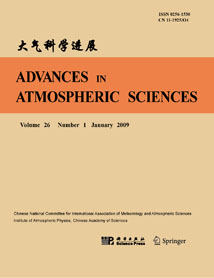| [1] |
Qin XU, Wei GU, GAO Shouting,
2005: Nonlinear Oscillations of Semigeostrophic Eady Waves in the Presence of Diffusivity, ADVANCES IN ATMOSPHERIC SCIENCES, 22, 49-57.
doi: 10.1007/BF02930869
|
| [2] |
Xiaofan Li, Han-Ru Cho,
1997: Development and Propagation of Equatorial Waves, ADVANCES IN ATMOSPHERIC SCIENCES, 14, 323-338.
doi: 10.1007/s00376-997-0053-6
|
| [3] |
Wang Xingbao, Wu Rongsheng,
1999: Interaction of Orographic Disturbance with Front, ADVANCES IN ATMOSPHERIC SCIENCES, 16, 467-481.
doi: 10.1007/s00376-999-0024-1
|
| [4] |
LI Yuefeng,
2007: Conversion of Kinetic Energy from Synoptic Scale Disturbance to Low-Frequency Fluctuation over the Yangtze River Valley in the Summers of 1997 and 1999, ADVANCES IN ATMOSPHERIC SCIENCES, 24, 591-598.
doi: 10.1007/s00376-007-0591-y
|
| [5] |
Dehai LUO, Binhe LUO, Wenqi ZHANG,
2023: A Perspective on the Evolution of Atmospheric Blocking Theories: From Eddy-Mean flow Interaction to Nonlinear Multiscale Interaction, ADVANCES IN ATMOSPHERIC SCIENCES, 40, 553-569.
doi: 10.1007/s00376-022-2194-z
|
| [6] |
Xu Jianjun,
1993: Quasi-40-Day Oscillation and Its Teleconnection Struc-ture together with the Possible Dependence on Conversion of Barotropic Unstable Energy of Temporal Mean Flow, ADVANCES IN ATMOSPHERIC SCIENCES, 10, 193-200.
doi: 10.1007/BF02919141
|
| [7] |
Fang Juan, Wu Rongsheng,
2002: Energetics of Geostrophic Adjustment in Rotating Flow, ADVANCES IN ATMOSPHERIC SCIENCES, 19, 845-854.
doi: 10.1007/s00376-002-0049-1
|
| [8] |
Zheng Xingyu, Zeng Qingcun, Huang Ronghui,
1991: The Propagation of Inertia-Gravity Waves and Their Influence on Mean Zonal Flow, Part One: the Propagation of Inertia-Gravity Waves, ADVANCES IN ATMOSPHERIC SCIENCES, 8, 431-446.
doi: 10.1007/BF02919266
|
| [9] |
Zhang Renhe, Chao Jiping,
1993: Unstable Tropical Air-Sea Interaction Waves and Their Physical Mechanisms, ADVANCES IN ATMOSPHERIC SCIENCES, 10, 61-70.
doi: 10.1007/BF02656954
|
| [10] |
KE Zongjian, DONG Wenjie, ZHANG Peiqun, WANG Jin, ZHAO Tianbao,
2009: An Analysis of the Difference between the Multiple Linear Regression Approach and the Multimodel Ensemble Mean, ADVANCES IN ATMOSPHERIC SCIENCES, 26, 1157-1168.
doi: 10.1007/s00376-009-8024-8
|
| [11] |
CHEN Hua*,
2015: Downstream Development of Baroclinic Waves in the Midlatitude Jet Induced by Extratropical Transition: A Case Study, ADVANCES IN ATMOSPHERIC SCIENCES, 32, 528-540.
doi: 10.1007/s00376-014-3263-8
|
| [12] |
Chao Jiping, Ji Zhengang,
1985: ON THE INFLUENCES OF LARGE-SCALE INHOMOGENEITY OF SEA TEMPERATURE UPON THE OCEANIC WAVES IN THE TROPICAL REGIONS——PART I : LINEAR THEORETICAL ANALYSIS, ADVANCES IN ATMOSPHERIC SCIENCES, 2, 295-306.
doi: 10.1007/BF02677245
|
| [13] |
Ji Zhengang, Chao Jiping,
1986: ON THE INFLUENCES OF LARGE-SCALE INHOMOGENEITY OF SEA TEMPERATURE UPON THE OCEANIC WAVES IN THE TROPICAL REGIONS PART II: LINEAR NUMERICAL EXPERIMENTS, ADVANCES IN ATMOSPHERIC SCIENCES, 3, 238-244.
doi: 10.1007/BF02682557
|
| [14] |
Zhu Keyun,
2001: On the 4D Variational Data Assimilation with Constraint Conditions, ADVANCES IN ATMOSPHERIC SCIENCES, 18, 1131-1145.
doi: 10.1007/s00376-001-0028-y
|
| [15] |
Qiu Jinhuan,
1999: Constraint Inversion Algorithm of Lidar Equation for Deriving Aerosol Optical Property, ADVANCES IN ATMOSPHERIC SCIENCES, 16, 216-228.
doi: 10.1007/BF02973083
|
| [16] |
Zheng Xingyu, Zeng Qingcun, Huang Ronghui,
1992: The Propagation of Inertia-Gravity Waves and Their Influence on Zonal Mean Flow Part Two: Wave Breaking and Critical Levels, ADVANCES IN ATMOSPHERIC SCIENCES, 9, 29-36.
doi: 10.1007/BF02656927
|
| [17] |
Luo Dehai, Li Jianping,
2000: Barotropic Interaction between Planetary- and Synoptic-Scale Waves during the Life Cycles of Blockings, ADVANCES IN ATMOSPHERIC SCIENCES, 17, 649-670.
doi: 10.1007/s00376-000-0026-5
|
| [18] |
LUO Dehai, LIU Jinting, LI Jianping,
2010: Interaction between Planetary-Scale Diffluent Flow and Synoptic-Scale Waves During the Life Cycle of Blocking, ADVANCES IN ATMOSPHERIC SCIENCES, 27, 807-831.
doi: 10.1007/s00376-009-9074-7
|
| [19] |
Luo Dehai,
1999: Nonlinear Three-Wave Interaction among Barotropic Rossby Waves in a Large-scale Forced Barotropic Flow, ADVANCES IN ATMOSPHERIC SCIENCES, 16, 451-466.
doi: 10.1007/s00376-999-0023-2
|
| [20] |
Liu Xuanfei, Zhu Qiangen, Guo Pinwen,
2000: Conversion Characteristics between Barotropic and Baroclinic Circulations of the SAH in Its Seasonal Evolution, ADVANCES IN ATMOSPHERIC SCIENCES, 17, 129-139.
doi: 10.1007/s00376-000-0049-y
|















 AAS Website
AAS Website 
 AAS WeChat
AAS WeChat 
 DownLoad:
DownLoad: